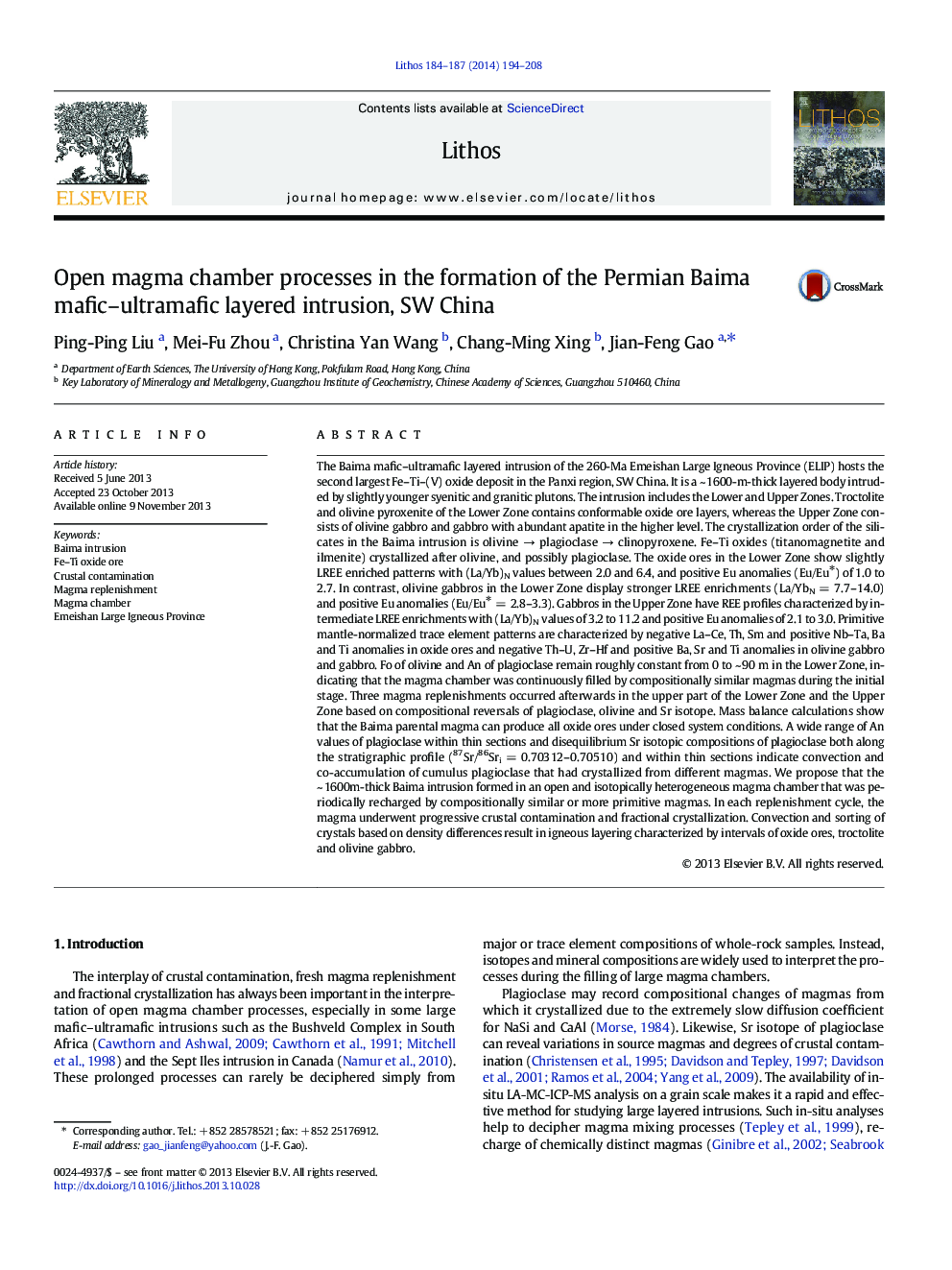| کد مقاله | کد نشریه | سال انتشار | مقاله انگلیسی | نسخه تمام متن |
|---|---|---|---|---|
| 4716128 | 1638683 | 2014 | 15 صفحه PDF | دانلود رایگان |

• The Baima intrusion formed from continuous magma influxes at the initial stage.
• Fe–Ti oxides crystallized later after olivine and possibly plagioclase.
• Progressive crustal contamination happened during the emplacement of the magma.
• Oxide ores and layering did not necessarily result from magma flow-through system.
The Baima mafic–ultramafic layered intrusion of the 260-Ma Emeishan Large Igneous Province (ELIP) hosts the second largest Fe–Ti–(V) oxide deposit in the Panxi region, SW China. It is a ~ 1600-m-thick layered body intruded by slightly younger syenitic and granitic plutons. The intrusion includes the Lower and Upper Zones. Troctolite and olivine pyroxenite of the Lower Zone contains conformable oxide ore layers, whereas the Upper Zone consists of olivine gabbro and gabbro with abundant apatite in the higher level. The crystallization order of the silicates in the Baima intrusion is olivine → plagioclase → clinopyroxene. Fe–Ti oxides (titanomagnetite and ilmenite) crystallized after olivine, and possibly plagioclase. The oxide ores in the Lower Zone show slightly LREE enriched patterns with (La/Yb)N values between 2.0 and 6.4, and positive Eu anomalies (Eu/Eu⁎) of 1.0 to 2.7. In contrast, olivine gabbros in the Lower Zone display stronger LREE enrichments (La/YbN = 7.7–14.0) and positive Eu anomalies (Eu/Eu⁎ = 2.8–3.3). Gabbros in the Upper Zone have REE profiles characterized by intermediate LREE enrichments with (La/Yb)N values of 3.2 to 11.2 and positive Eu anomalies of 2.1 to 3.0. Primitive mantle-normalized trace element patterns are characterized by negative La–Ce, Th, Sm and positive Nb–Ta, Ba and Ti anomalies in oxide ores and negative Th–U, Zr–Hf and positive Ba, Sr and Ti anomalies in olivine gabbro and gabbro. Fo of olivine and An of plagioclase remain roughly constant from 0 to ~ 90 m in the Lower Zone, indicating that the magma chamber was continuously filled by compositionally similar magmas during the initial stage. Three magma replenishments occurred afterwards in the upper part of the Lower Zone and the Upper Zone based on compositional reversals of plagioclase, olivine and Sr isotope. Mass balance calculations show that the Baima parental magma can produce all oxide ores under closed system conditions. A wide range of An values of plagioclase within thin sections and disequilibrium Sr isotopic compositions of plagioclase both along the stratigraphic profile (87Sr/86Sri = 0.70312–0.70510) and within thin sections indicate convection and co-accumulation of cumulus plagioclase that had crystallized from different magmas. We propose that the ~ 1600m-thick Baima intrusion formed in an open and isotopically heterogeneous magma chamber that was periodically recharged by compositionally similar or more primitive magmas. In each replenishment cycle, the magma underwent progressive crustal contamination and fractional crystallization. Convection and sorting of crystals based on density differences result in igneous layering characterized by intervals of oxide ores, troctolite and olivine gabbro.
Journal: Lithos - Volumes 184–187, January 2014, Pages 194–208